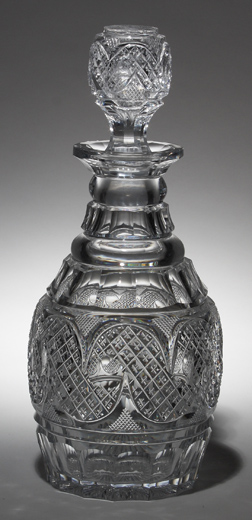Persistent and pervasive
This decanter helps teach the most important lesson required for a collector of early cut glass—that patterns alone are an unreliable guide for either dating or attributing cut glass.

It is cut in one of the most attractive and highly sought after patterns seen on 1830s American cut glass—broad S-shaped scrolls linked together by polished circles. Yet when I bought it, I knew that something strange was going on.
An 1830s tumbler and decanter cut in this pattern are in the case of early American cut glass at the Corning Museum of Glass. Back in the 1940s, Mrs J. Amory Haskell had a matching sugar bowl, decanter and pitcher. All of these were no doubt made in New York City in the 1830s, possibly by an immigrant cutter from France or Belgium. Variants of this, and many of the other highly inventive cut designs then current in France and Belgium, are shown in the sketchbook of Belgian Hubert Ponthière who cut glass in the 1830s at Vonêche and Zoude.
And I know that the same pattern was being cut in New York in the 1850s, again probably by French immigrants.
But this decanter is neither French nor American. It is English. It was made in the early 1880s. It is one of many backward-looking wares illustrated in pen and ink in the design book of Stevens and Williams of Brierley Hill near Stourbridge in the English West Midlands. It is pattern 8098 in their design book for 1882-3.
Here's the lesson. Once introduced, a pattern could be cut at any time. However, unless a manufacturer went out of his way to recreate the past, it is likely to be in some way readapted. It will be adapted to a different blank—here upon one that is of the wrong shape, too heavy, too clear and with a stopper that is proportionately too small and not spherical enough. It may be complemented with cutting that attempts to improve it beyond the original—its thick neck is deeply cut with flutes and horizontal pillars that belong to the late 1830s or early 1840s.
And yet, while it is out of the place in the 1830s, it is a fine, strongly dated and attributed 1880s reinterpretation of 1830s glass.
The attribution to Stevens and Williams came as a side-discovery while researching something else. I was following a hunch that a quite different piece might have been made by S&W in that period by plowing through reel after reel of microfilm at Corning's Rakow Library. S&W's design books show an astonishing variety of objects, both expected and unexpected. A source for this decanter was the last thing that I expected to find!
For an 1880s American reinterpretation of the 1830s, see this.

